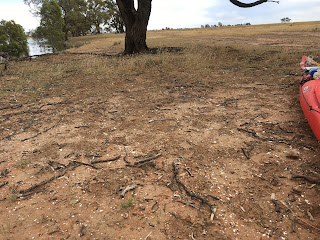Friggincharlies's Hut: Hattah Kulkyne National Park to Mallee Cliffs State Forest (near Nangiloc).
When passing through Hattah Kulkyne National Park make sure you take the time to go for a walk amongst the sandhills. My camp at the base of one of those sandhills was chosen mostly because it afforded me shelter from the wind, but turned out to be a full of birdlife. While I was sitting on my boat cooking dinner a group of rainbow bee-eaters were hunting, so too a large group of fairy martins, both acrobatic gliders. Wanting to join in on the fun a flock of short billed corella glid over the Murray to land in a dead tree, adjusting for the wind, but not flapping. Only one stuffed up the landing. On the sand hill were bablers and a flock of finches, there was also the smallest little song bird, the size of a pardalotte but with the most beautiful voice. Looking it up (there's an app for that) I found it was called a red lored whistler. The landscape is totally different to the Redgum forest that follows the river. Taking a walk through the dunes you walk through casuarina groves, mallee vegetation and open grasslands. It is this intersection between landscape types that creates the diversity of life the national park is famous for. It doesn't take long to get spectacular views of the river either.
In the morning I used the left over fuel in my metho stove to heat up a cup of soup, but otherwise hurried to get in my way. The clouds were building and there were enough dark ones to threaten rain. If I could get it into my boat quickly it would be dry for the evening.
Despite a few drops of rain, the clouds were initially little more than scenery. However, it did not take long for the wind to build, which it did. I faced my second day of 50km/hr headwinds! The long straights and reaches in this part of the river allow the waves to build when driven by a stiff breeze. Soon I found myself edging through white capped rollers. Most were around 30cm high, but of one straight they reached 60cm. I was glad that I had a good spray deck and jacket and that my holds were well sealed. Another boat might have sunk. After one such straight I met a MSB boat on its way to Mildura - and they said they found it difficult!
In such times it is difficult to do my photography. When I stop paddling to take my 250m recording shots of tree condition, the boat threatens to come to a standstill. If it does I lose steerage and the wind begins to turn me sideways to the waves. That's tricky. It's easy to tip. I left out my panorama shots, they take about 30 seconds and don't work out when the boat bounces. I tried to do my videos, but a lot were little more than 'oh here comes the wind again, better go'. Even the normal camera was too slow and complicated. I reverted to my pocket camera, because I could take a photo with one hand and leave the other holding the paddle. This way i managed to get photos in all but the worst conditions, where safety meant the common sense thing was to concentrate on surviving what the weather was throwing at me. Keeping calm was key: deep, slow, steady strokes, not too long or high, least the wind catch the high blade and unbalance you. Flooded landscapes are not the best for swimming, or getting back into the boat. Self talk helped. Slow down, keep calm, concentrate.
Like Wemen, Colignan is situated at the top of a sandhill. It probably offers residents great views of the river and surrounding forest as well as bring flood safe, but it makes them difficult to get to from the river. The only stop I had was at Mt. Dispersion, named after a botched attempt to scare away a group of aboriginals who had been following the explorer Major Mitchell ended with seven shot dead. So not really dispersed, but also more of a sandhill than a mountain. I think the heat may have been getting to him.
Sheltered high ground was hard to find today. With the winds, waves and rain starting to take their toll on my energy reserves I found shelter and set up my tent on the veranda of a bush hut. Out of the wind and rain I could cook up a warm meal and dry my gear. The best thing about the hut was its name, 'Friggincharlies Hut'. Thanks Friggincharlie. I promise to leave no sign of my passing.
Despite the wind, paddling through the Hattah Kulkyne National Park and Mallee Cliffs State Forest has been one of the prettiest stretches on the river so far. Just as impressive as in low water, when it is popular amongst campers for its long beaches, but very different at this level.
I am beginning to realise how important it is in my quest to understand the river, that I get to know it in both high and low water. It is challenging at this level, but I'm glad I'm out here, giving it a go.
Tomorrow the wind should drop - I hope.































